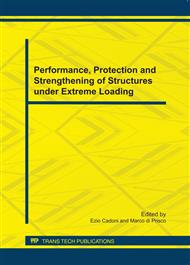p.247
p.253
p.259
p.266
p.272
p.278
p.284
p.290
p.296
Load Redistribution Using Compressive Membrane Action in Reinforced Concrete Buildings
Abstract:
The primary function of any designed structure is to be able to support pre-determined static loads which allow the building to be occupied for its intended use. In the design process the unlikely event that the building is damaged must be considered. Often the focus is directed to the loss of primary loading elements that are fundamental to the integrity of the structure. The damage that is caused as a consequence may propagate causing collapse of surrounding elements culminating with the loss of an extensive proportion of the floor area. To prevent collapse inherent alternative load paths can be utilised. Both the elastic and plastic approved methods for the design of reinforced concrete in modern codes of practice neglect the effect of membrane forces. It has been recognised for some time that the omission of compressive membrane action (CMA), also described as ‘arching action’, can lead to a significant underestimation of load capacity. Previous studies which have attempted to determine if CMA is capable of supporting damaged columns under accidental loading conditions have not had supporting experimental testing of slabs at appropriate span to depth ratios. This paper presents an experimental program conducted on laterally restrained slab strips at approximately half scale. Combined with an analytical study, the extent to which CMA can be used as an effective robustness tool has been assessed.
Info:
Periodical:
Pages:
272-277
Citation:
Online since:
July 2011
Authors:
Price:
Сopyright:
© 2011 Trans Tech Publications Ltd. All Rights Reserved
Share:
Citation:


